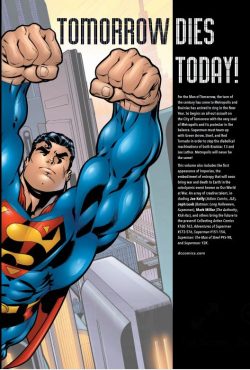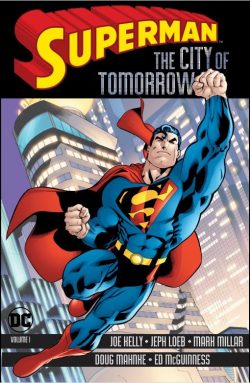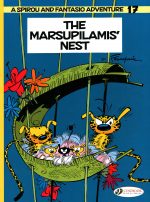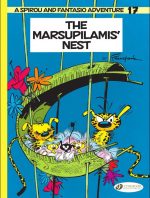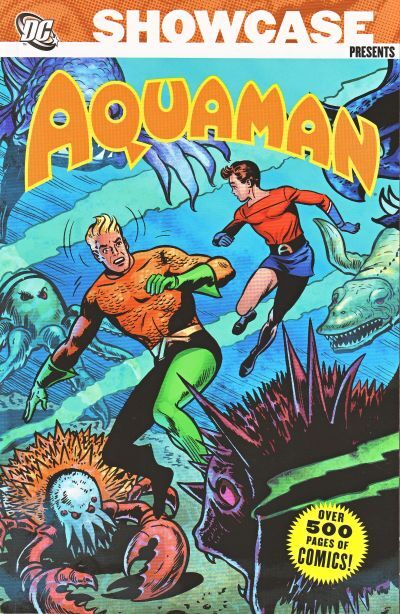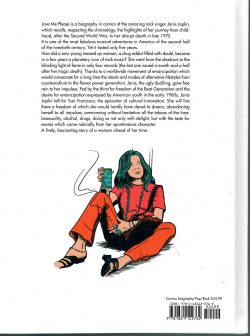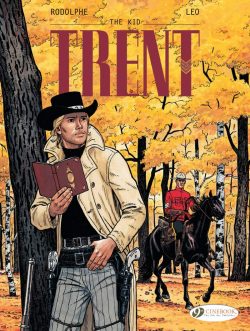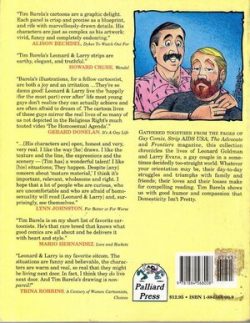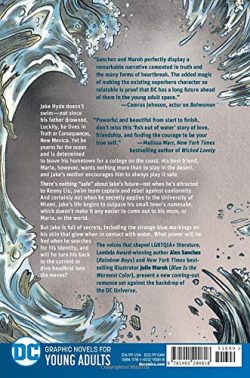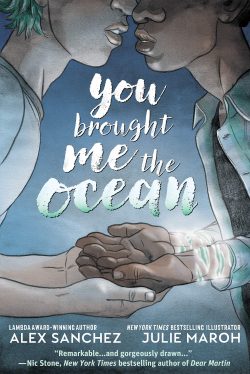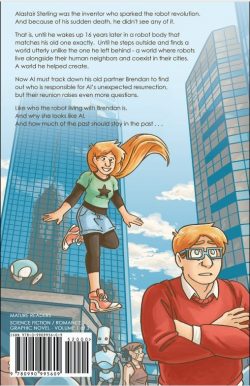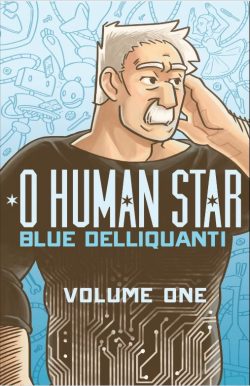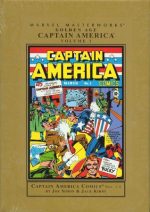
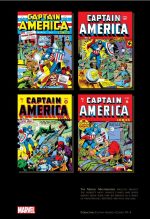
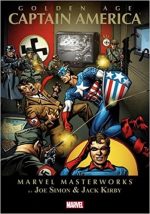
By Joe Simon & Jack Kirby with & various (Marvel Comics)
ISBN: 978-0-7851-1619-2 (HB) 978-0785157939 (TPB)
Arguably the biggest anniversary in this year of comics milestones is this guy. Whatever your real-world politics, this is a fictive icon without peer – unless you count Wonder Woman, Archie Andrews or the others as your favourite. Maybe we should just celebrate them all like Catholics and Saints…
Golden Age Captain America Marvel Masterworks volume 1- available in hardback, trade paperback and as an eBook – reprints the first four issues of original title Captain America Comics (cover-dated March to June 1941) and are a landmark combination of passion, enthusiasm and creative quality seldom seen at Marvel’s brash predecessor Timely Comics, who generally settled for any two out of three…
However, for true fans the groundbreaking and exceptional patriotic material generated by Joe Simon & Jack Kirby is not really the lure here… the real gold nuggets for us old sods are those rare back-up features from the star duo and their small team of talented youngsters. Reed Crandall, Syd Shores, Alex Schomburg and the rest worked on main course and filler features such as Hurricane, the God of Speed and Tuk, Caveboy: strips barely remembered, yet still brimming with the creative fires of legends in waiting.
Devised at the end of 1940 and boldly launched in his own monthly title with none of the publisher’s customary cautious shilly-shallying, Captain America Comics #1 was cover-dated March 1941 and was an instant monster, blockbuster smash-hit. The bombastic Sentinel of Liberty was instantly the absolute and undisputed star of Timely’s “Big Three†– the other two being the Human Torch and Sub-Mariner (as seen in Marvel Mystery Comics) – and one of the first to fall from popularity at the end of the Golden Age.
In comparison to their contemporaries at Quality, Fawcett, National/All American and Dell, or Will Eisner’s The Spirit newspaper strips, the standard of most Timely periodicals was woefully lacklustre in both story and – most tellingly – art. That they survived and prospered is a Marvel mystery, but a clue might lie in the sheer exuberant venom of their racial stereotypes and heady fervour of jingoism at a time when America was involved in the greatest war in world history. I suspect given the current tone of the times politically, such sentiments might be less controversial now than they have been for quite a while…
Nevertheless, the first ten Captain America Comics are the most exceptional comics in the fledgling company’s history, and I can’t help but wonder what might have been had National (née DC) been wise enough to hire Simon & Kirby before they were famous, instead of after that pivotal first year?
Of course, we’ll never know and although they did jump to the majors after a year, Simon & Kirby’s visual dynamism became the aspirational and approved house-style for superhero comics at the company they left and their banner-bedecked creation became the flagship icon for them and the industry.
Following a revelatory look back from Golden Age maven and comics scribe supreme Roy Thomas, this initial volume opens with ‘Case No. 1: Meet Captain America’ by Simon & Kirby (with additional inks by Al Liederman) wherein we see how scrawny, enfeebled young patriot Steven Rogers, continually rejected by the US Army, is recruited by the Secret Service.
Desperate to counter a wave of Nazi-sympathizing espionage and sabotage, this passionate young man is invited to become part of a clandestine experimental effort create physically perfect super-soldiers. However, when a vile Nazi agent infiltrates the project and murders its key scientist, Rogers became the only successful graduate and America’s not-so-secret weapon.
Sent undercover as a simple private, Rogers soon encounters Bucky Barnes: a headstrong, orphaned Army Brat who becomes his sidekick and costumed confidante. All of that is perfectly packaged into mere seven-and-a-half pages, with untitled ‘Case No. 2’ taking just as long to resoundingly defeat Nazi showbiz psychics Sando and Omar as they spread anxiety and fear amongst the gullible Americans.
‘Captain America and the Soldier’s Soup’ is a rather mediocre and unattributed prose tale promptly followed by splendidly sinister 16-page epic ‘Captain America and the Chess-board of Death’, with our heroes thrashing more macabre murdering Nazi malcontents before facing the groundbreaking introduction of the nation’s greatest foe.
Solving ‘The Riddle of the Red Skull’ proves to be a thrill-packed, horror-drenched master-class in comics excitement…
The first of the B-features follows as Hurricane (“Son of Thor†and last survivor of the Greek Gods – don’t blame me, that’s what it says) sets his super-fast sights on ‘Murder Inc.’ in a rip-roaring but clearly rushed battle against fellow-immortal Pluto (so not quite the last god either; nor exclusively Norse or Greek…) who is once again using mortals to foment pain, terror and death…
Hurricane was a rapid reworking and sequel to Kirby’s ‘Mercury in the 20th Century’ from Red Raven Comics #1 (August 1940) whereas ‘Tuk, Caveboy: Stories from the Dark Ages’ is all-original excitement starring a teenaged boy in 50,000 BC raised by a beast-man. The wild child is resolved to regain the throne of his antediluvian kingdom Attilan from the usurpers who stole it…
This is an imaginative barbarian spectacular owing much to Tarzan and The Land that Time Forgot, but certainly delivers the thrills we might want…
Historians believe Kirby pencilled this entire issue and although no records remain, inkers as diverse as Liederman, Crandall, Bernie Klein, Al Avison, Al Gabrielle, Syd Shores and others may have been involved in this and subsequent issues…
Captain America Comics #2 screamed onto the newsstands a month later, boldly opening with monster mash-up ‘The Ageless Orientals Who Wouldn’t Die’: blending equal amounts of horror and jingoism into a terrifying thriller with a ruthless American capitalist exposed as the true source of a rampage against the nation’s banks…
‘Trapped in the Nazi Stronghold’ sees Cap and Bucky in drag and in Europe to rescue a pro-British financier kidnapped by the Nazis, whilst ‘Captain America and the Wax Statue that Struck Death’ returned to movie-thriller themes in the tale of a macabre murderer with delusions of world domination.
The Patriotic Partners deal with saboteurs in prose piece ‘Short Circuit’ before Tuk tackles monsters and mad priests in ‘The Valley of the Mist’ (by either the King and a very heavy inker or an unnamed artist doing a passable Kirby impression) whilst Hurricane – now “Master of Speed†– swiftly and spectacularly expunges ‘The Devil and the Green Plague’ deep in the fetid heart of the Amazon jungles.
CAC #3 led with 17-page epic ‘The Return of the Red Skull’ with the scarlet scoundrel booting Adolf Hitler off the cover-spot he’d hogged in #1 and #2 as Kirby opened up his layouts to enhance the mesmerising graphic action with a veritable production line of creators (including Ed Herron, Martin A, Burnstein, Howard Ferguson, William Clayton King, and possibly George Roussos, Bob Oksner, Max Elkan and Jerry Robinson) joining the creative team.
Despite eye-shattering scale and spectacle united with non-stop action and eerie mood as key components of the Sentinel of Liberty’s exploits, horror elements dominated ‘The Hunchback of Hollywood and the Movie Murder’ wherein a patriotic film is plagued by sinister and disturbing “accidentsâ€â€¦
Stan Lee debuts with text tale ‘Captain America Foils the Traitor’s Revenge’ before Simon & Kirby – and friends – recount ‘The Queer Case of the Murdering Butterfly and the Ancient Mummies’ in a riotous blending of eerie Egyptian antiquities and myths with a thoroughly modern costumed psychopath.
Tuk (drawn by either Mark Schneider – or perhaps Marcia Snyder) reaches ‘Atlantis and the False King’, after which Kirby contributes a true tale in ‘Amazing Spy Adventures’ whilst Hurricane confronts ‘Satan and the Subway Disasters’with devastating and final effect…
The final issue in this fabulous curated chronicle opens with ‘Captain America and the Unholy Legion’ as the star-spangled brothers-in-arms crush a murderous conspiracy of beggars terrorising the city, before taking on ‘Ivan the Terrible’ in a time-bending vignette and thereafter solving ‘The Case of the Fake Money Fiends’.
Their all-action exploits culminate in magnificent fashion when our heroes then expose the horrendous secret of ‘Horror Hospital’…
Lee-scripted text tale ‘Captain America and the Bomb Sight Thieves’ leads to young Tuk triumphing over ‘The Ogre of the Cave-Dwellers’ before Hurricane brings down a final curtain on ‘The Pirate and the Missing Ships’.
An added and very welcome bonus for fans is the inclusion of all the absolutely beguiling house-ads for other titles and upcoming Cap books; contents pages; Sentinels of Liberty club bulletins; assorted pin-ups; merchandise and memorabilia and Joe Simon’s Afterword ‘My Bulletin Board’…
Despite in many ways having a much shallower vintage well to draw from, this particular tome from the House of Ideas is a book that will always stands amongst the very best that the Golden Age of Comics can offer and should be on every fan’s “never-miss†bookshelf.
© 2018 MARVEL. All rights reserved.

